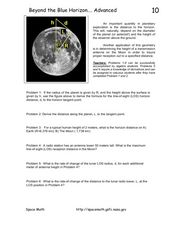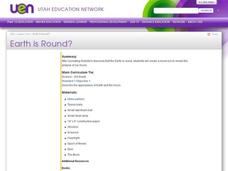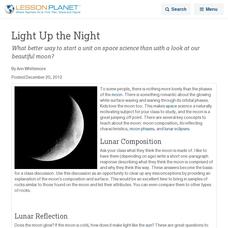Curated OER
Lunar Field Trip
Young scholars take a virtual tour on Google Moon of what human life would be like on the moon. In this moon lesson plan, students also compose web diagrams, make charts, make a time line, investigate problems, and more.
Curated OER
Lesson Plan # 1 - Phases of the Moon
Learners explore and identify moon phases, watch teacher demonstration of different phases using globe and flashlight to represent moon and sun, and discuss reasons why there are moon phases.
Curated OER
Water on the Moon!
In this moon worksheet, students read about the data collected from the Deep Impact/EPOXI and Cassini missions to the moon that have detected the presence of hydroxyl molecules under the moon's polar craters. Students solve 4 problems...
K5 Learning
The Moon
Second graders read a short informational text passage about the moon and answer a series of questions based on what they read.
S2tem Centers SC
Seasons
Winter, spring, summer, and fall—take the learning of the seasons beyond the elementary level to the middle school classroom. Curious learners begin by watching videos about the seasons and the rotation of planet Earth. Then, they...
Curated OER
The Earth and Beyond
Photographs and graphics bring the solar system and Earth to life in this presentation. Viewers are taken on a virtual field trip, beginning with the sun and planet placement, and proceeding through both Earth and the moon's movements....
Curated OER
LCROSS 'Sees" Water on the Moon!
In this moon activity, students calculate information about the crater that was created by a massive impact. This activity has 3 problems to solve.
Curated OER
Beyond the Blue Horizon...Advanced
In this calculating the horizon worksheet, high schoolers solve 6 problems using algebra, derivatives and calculus to find the formula for the line-of-sight horizon, the distance along a planet, the horizon distance and the rates of...
Curated OER
Earth is Round?
Third graders discuss how Aristotle concluded that the Earth was round. As a class, they review theories about the Earth's shape and describe how life on Earth would be different if it were flat. Individually, they make a moon book in...
Curated OER
Time Intervals
For this time intervals worksheet, students solve 8 problems where they determine the time gamma-ray bursts last, the time black hole micro-flares are emitted, the time coronal mass ejections travel and the days between lunar phases of...
Curated OER
LRO Sees Apollo 11 on the Moon!
In this moon image worksheet, students determine the scale of an image taken by the LRO satellite of the Apollo 11 landing site. Students calculate the sun's angle at the time of the photograph using the shadow of the Lunar Lading...
NASA
Roving on the Moon
Take a rover out for a test drive. The challenge is to build a rubber-band-powered rover out of cardboard. Individuals or groups work at making modifications to a prototype rover to increase its efficiency.
Curated OER
Is It Lunar or Lunacy?
Sixth graders are introduced to the moon and its phases. Individually, they draw a sketch of each phase of the moon and read a short article about Galileo. To end the lesson, they examine the difference between refracting and...
Curated OER
Moon Glow
Students identify the Earth-Moon relationship and the phases of the Moon. They participate in an activity that illustrates why the Moon has so many different looks within a lunar cycle. They discuss solar and lunar eclipses.
Curated OER
The Apollo-11 Landing Area at High-Resolution
In this moon crater activity, students use images of craters taken from the Lunar Reconnaissance Orbiter to determine the size of the craters. This activity has 6 problems to solve.
Curated OER
Demonstrating Moon Phases
Third graders participate in a demonstration of the moon's phases. In this moon phase lesson, 3rd graders watch as the teacher demonstrates moon phases with a bright light and a Styrofoam ball. They answer questions associated with the...
Curated OER
How Do We Forecast Weather?
Third graders investigate how scientists collect weather data in order to forecast the weather. They work in small groups in order to research one type of weather technology such as, satellite images, radar, surface observations, or...
Mr. E. Science
Manned Space Exploration: From Apollo to Present
How did the manned space mission program progress? The presentation covers American space exploration from the Apollo missions through the International Space Station.
Curated OER
ESL Open Cloze Worksheet- English Grammar
In this ESL open cloze worksheet, students fill in the blanks in 8 sentences. They use words related to English grammar, vocabulary words, to fill each blank.
Curated OER
Volcanoes are a Blast-Working with Simple Equations
For this projectile motion worksheet, students solve 3 problems and an inquiry problem using three equations that describe projectile motion. One equation is for the maximum velocity to reach a height, H, the other is the maximum...
Curated OER
Where Did All the Stars Go?
In this brightness of stars instructional activity, students solve 4 problems given a unit of measurement of cents/second for brightness. Students find cents collected in timed exposures, they find brightness of stars and they determine...
Curated OER
Excite the Night with a Look at the Moon
What better way to start a unit on space science than with a look at our beautiful moon?
Curated OER
Regolith Formation
Students explain the difference between regolith formation on Earth and the Moon. For this space science lesson, students model the different factors affecting regolith formation on Earth. They identify the different types of weathering.
Messenger Education
Look But Don’t Touch—Exploration with Remote Sensing
Mars is home to the tallest mountain in our solar system, Olympus Mons. In this set of two activities, learners review geologic land formations through the analysis of aerial maps. They then apply this knowledge to aerial maps of objects...

























